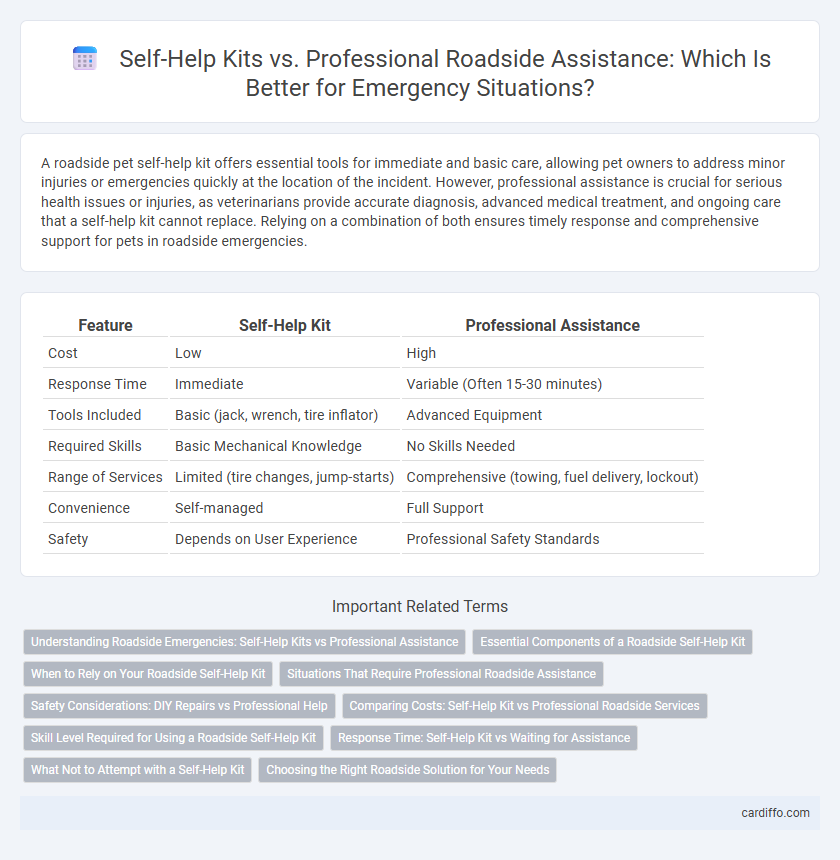A roadside pet self-help kit offers essential tools for immediate and basic care, allowing pet owners to address minor injuries or emergencies quickly at the location of the incident. However, professional assistance is crucial for serious health issues or injuries, as veterinarians provide accurate diagnosis, advanced medical treatment, and ongoing care that a self-help kit cannot replace. Relying on a combination of both ensures timely response and comprehensive support for pets in roadside emergencies.
Table of Comparison
| Feature | Self-Help Kit | Professional Assistance |
|---|---|---|
| Cost | Low | High |
| Response Time | Immediate | Variable (Often 15-30 minutes) |
| Tools Included | Basic (jack, wrench, tire inflator) | Advanced Equipment |
| Required Skills | Basic Mechanical Knowledge | No Skills Needed |
| Range of Services | Limited (tire changes, jump-starts) | Comprehensive (towing, fuel delivery, lockout) |
| Convenience | Self-managed | Full Support |
| Safety | Depends on User Experience | Professional Safety Standards |
Understanding Roadside Emergencies: Self-Help Kits vs Professional Assistance
Self-help kits for roadside emergencies typically include essential tools such as jumper cables, tire inflators, and basic first-aid supplies that empower drivers to address minor breakdowns independently. Professional roadside assistance services offer advanced support including vehicle towing, mechanical repairs, and on-site diagnostics, ensuring comprehensive safety and swift resolution in complex situations. Understanding the scope and limitations of each option helps drivers prepare effectively for varying roadside emergencies, balancing convenience with specialized expertise.
Essential Components of a Roadside Self-Help Kit
A well-equipped roadside self-help kit includes essential components such as a high-visibility safety vest, jumper cables, a tire pressure gauge, and a sturdy flashlight with extra batteries. Basic tools like a multi-tool, reflective warning triangles, and first-aid supplies enhance preparedness during vehicle breakdowns, enabling effective immediate response. These components provide critical support before professional roadside assistance arrives, reducing wait times and improving safety.
When to Rely on Your Roadside Self-Help Kit
Relying on your roadside self-help kit is ideal for minor vehicle issues such as changing a flat tire, jump-starting a battery, or replacing small fuses, allowing quick and cost-effective resolutions without waiting for external help. Essential tools include a jack, lug wrench, jumper cables, reflective triangles, and basic hand tools, ensuring preparedness for common roadside emergencies. For complex problems involving engine malfunctions, transmission failures, or severe accidents, seeking professional assistance from qualified roadside service providers ensures safety and proper vehicle handling.
Situations That Require Professional Roadside Assistance
Situations requiring professional roadside assistance include severe mechanical failures, such as engine breakdowns or transmission issues, that cannot be resolved with a self-help kit. Complex tire damage beyond a simple puncture repair, locked keys inside the vehicle, and electrical system malfunctions also necessitate expert intervention. Professional assistance ensures safe and efficient resolution in emergencies where specialized tools and technical knowledge are critical.
Safety Considerations: DIY Repairs vs Professional Help
DIY roadside repairs with a self-help kit can address minor issues like tire changes or battery jumps, but safety risks increase significantly without proper training and equipment. Professional assistance ensures expert handling of complex repairs, reducing the likelihood of injury or vehicle damage on busy roads. Prioritizing professional help improves roadside safety by leveraging specialized tools, expertise, and situational awareness.
Comparing Costs: Self-Help Kit vs Professional Roadside Services
Self-help kits typically cost between $20 and $100, offering essential tools for minor roadside repairs, while professional roadside services usually range from $50 to $200 per service call depending on the type of assistance and location. Investing in a self-help kit can save money on towing or labor fees but may require time and basic mechanical knowledge. Professional assistance ensures faster, expert help, often covered by roadside insurance plans, adding convenience and reducing the risk of improper repairs.
Skill Level Required for Using a Roadside Self-Help Kit
Using a roadside self-help kit requires a moderate level of mechanical skill and basic knowledge of vehicle systems, such as understanding how to change a tire or jump-start a battery. Individuals with limited automotive experience may struggle to effectively use the tools and follow instructions, increasing the risk of improper repairs or personal injury. Professional roadside assistance offers expertise and specialized equipment, ensuring accurate diagnosis and safe resolution of complex vehicle issues beyond the scope of typical self-help kits.
Response Time: Self-Help Kit vs Waiting for Assistance
A self-help kit provides immediate tools and resources to address minor roadside issues, significantly reducing response time compared to waiting for professional assistance. While professional help ensures expert repair and safety, the average arrival time can range from 30 minutes to over an hour depending on location and traffic conditions. Utilizing a self-help kit enhances on-the-spot problem resolution, minimizing delay and improving overall roadside efficiency.
What Not to Attempt with a Self-Help Kit
Avoid attempting complex mechanical repairs or electrical system diagnostics with a self-help kit, as improper handling may worsen vehicle issues or cause safety hazards. Do not try to fix major engine problems, transmission failures, or brake system faults without professional expertise and specialized tools. Prioritize calling roadside assistance for towing or technical services when encountering severe breakdowns beyond basic tire changes or battery jumps.
Choosing the Right Roadside Solution for Your Needs
Self-help kits offer convenient and cost-effective solutions for minor roadside issues, equipping drivers with essential tools for quick fixes like tire changes or battery jumps. Professional assistance provides expert support for complex problems such as engine failures or accident recovery, ensuring safety and comprehensive repairs. Selecting the right roadside solution depends on assessing the severity of the issue, available skills, and the urgency of return to the road.
Self-Help Kit vs Professional Assistance Infographic

 cardiffo.com
cardiffo.com